Corn Ethanol Boom in Brazil






PHOTO: FS BIOENERGIA
May 22, 2022
BY Katie Schroeder
Ethanol plants are multiplying across west-central Brazil. The plants themselves are not unusual, due to the fact that Brazil is a key consumer of biofuels and the second-largest producer of ethanol worldwide, but it’s the feedstock these plants process that is drawing attention. The Brazilian ethanol industry primarily uses sugarcane as its feedstock; however, corn ethanol plants are popping up throughout the Brazilian states of Mato Grosso, Mato Grosso do Sul and Goias. FS Bioenergia was the early leader in the corn-only ethanol industry, installing the first corn-only ethanol plant in 2017. Justin Kirchhoff, president of Summit Ag Investors, majority owner of FS Bioenergia, says the Brazilian ethanol market has “the combination of growth in that market and … a fundamentally lower carbon intensity score that presents a very unique opportunity.” This first plant was designed by engineering and technology company ICM Inc. Issam Stouky, director of global business development with ICM, gives insight into the Brazilian ethanol market and describes its unique makeup.
The Basics of the Brazilian Ethanol Market
The ethanol market in Brazil has several unique factors differentiating it from other markets across the globe. These differences include the use of biomass to power ethanol plants, the well-established demand for ethanol, primary use of sugarcane as a feedstock and the use of hydrous ethanol. Stouky says that Brazil is a complex market to invest in. “Understanding the local ethanol industry and its drivers, from biomass and corn origination to product offtake and distribution channels, is paramount to be successful.” Ethanol plants in Brazil—from any feedstock—are capital intensive, but the ROI on corn-based ethanol is enticing with a shorter payback, he says. The ethanol market in Brazil is well-established and there is a steady demand for it, but the market for corn-based ethanol coproducts is still new.
“I think Brazilians in terms of their framework around fuel policy are just very forward-looking and allowed more of a market-oriented approach,” Kirchhoff says. “When you pull up to a gas station in Brazil you basically have three choices. You can either get diesel, you can get gasoline blended with 27 percent ethanol, or you can get 100 percent ethanol, and the consumer, for the most part, makes the choice on—just call it 100 percent ethanol or 27 percent ethanol basis price.” This “market-oriented approach” is what Kirchhoff believes has helped the Brazilian ethanol business grow long-term. He estimates that 40 to 50 percent of the liquid fuel used in the country is ethanol. Stouky explains that Brazil is also unique in that it is the only country where 100 percent ethanol, also known as hydrous ethanol, can be found in gas stations.
Ethanol plants in Brazil utilize biomass to power the plant, as a 2020 report from the USDA explains. The majority of ethanol plants make ethanol out of sugarcane, using the bagasse to power the plant. However, corn ethanol plants primarily use eucalyptus as the fuel source, though there are some companies experimenting with other biomass fuel sources, according to the report. “Plants in Brazil do self-cogenerate to make their own power and export excess power to the grid,” Stouky explains. “All facilities in Brazil have to cogenerate using biomass regardless of feedstock source.”
In March, the Brazilian government lifted tariffs on imported ethanol through the end of 2022. The tariffs had been previously set at 18 percent but were reduced in an effort to alleviate the pressures of inflation.
The Growth of Corn Ethanol
One of the major factors that inspired Summit to pursue corn ethanol production in Brazil was the availability of low-cost corn. “When biotechnology and crops continued to evolve, just call it 20 years ago, that allowed for them to produce two crops per year on the same acre of ground where historically they were only producing a crop of soybeans,” Kirchhoff says. “But as you were able to shorten up the maturities of both soybeans and corn, that unlocked the potential for them to produce a crop of soybeans followed by a second crop of corn. What that did was lower their overall cost of production, allowing for a very economic feedstock source for running corn ethanol plants in Mato Grosso.” The sugarcane ethanol industry remains prominent in Brazil as a legacy industry, however Kirchhoff expects that “the vast majority of new gallons produced in Brazil will come from corn-based ethanol.”
Bad sugarcane crops in recent years are part of the reason corn ethanol is growing. In an interview with BNamericas, Biatriz Pupo, biofuel senior analyst of S&P Global Platts Analytics, stated that, “In our vision, ethanol from corn will gain a lot of relevance. The sugarcane cycle takes a long time to get a return, so we foresee a boom in corn plants, with corn ethanol production jumping from 3 to 9 billion liters by 2030, corresponding to 20% of the total [projected production].”
The first corn-only ethanol plant was built by FS Bioenergia, a joint venture between U.S.-based Summit Agricultural Group and Tapajós Participações S.A. (formerly Fiagril). This 60 MMgy plant was designed by ICM and later expanded to produce 140 MMgy. Since the completion of construction in 2017, Brazil had a total of 16 corn-based ethanol plants with more under construction. According to the USDA report, Brazil’s Minister of Mines and Energy expects total ethanol production and consumption to grow to 43 billion liters by 2029, supported by the country’s new carbon credits program, RenovaBio.” Stouky has seen this play out in real time as the demand for corn-based ethanol plants has increased in recent years. The UNEM (National Union of Corn Ethanol) also projects an increase in corn ethanol production to 8 billion liters by 2028, the report states. In the current harvest season, which started in April, the production of corn ethanol grew 37.15 percent in the past year, while production of sugarcane ethanol was down 8.83 percent.
FS Bioenergia currently has two plants up and running, both of them engineered by ICM. Their first plant, built in Lucas do Rio Verde, came online in 2017 and currently produces 150 MMgy of corn-based ethanol. “It is the first greenfield corn-based ethanol [facility], a very efficient biorefinery, and very well operated,” Stouky says.
The second plant, located in Sorriso, Mato Grosso, came online in 2020 and currently produces 230 MMgy. “This is another example of a well-designed and operationally efficient plant that has exceeded our customer’s expectations,” Stouky says. These plants are the industry standard in Brazil, according to Stouky. Fitted with ICM’s proprietary Fiber Separation Technology and Selective Milling Technology, they have the ability to produce high-protein and high-energy feed. According to Kirchhoff, each plant also produces nearly three gallons of ethanol per bushel of corn.
The combined capacity of FS’ two plants is currently 380 MMly, but Kirchhoff says that number will soon grow. ICM is working with FS to design a third plant, located at Primavera do Leste in Mato Grosso. This plant will produce 160 MMly, bringing FS’ total production to 550 MMly when the plant becomes operational in June of 2023. FS is not alone in building new plants across west-central Brazil; ICM is also working with Neomille to build an ethanol plant in Maracaju, Mato Grosso Do Sul, and with Agribrasil to build a plant in Canarana, Mato Grosso.
ICM works with its clients providing engineering, plant design, process technology implementation and more, Stouky explains. Some of ICM’s patented process technologies that have been installed are Selective Milling Technology and Fiber Separation Technology which make value-added feed production possible. “You’re able to make two products: high-energy feed that is ideal for cattle, and high-protein feed that is beneficial to cattle, poultry, swine and aquaculture. With these technologies, our customer base has been able to produce feed with more than 45% protein content and diversify their revenues,” Stouky says.
Advantages and Challenges of Corn Ethanol
Corn has some benefits over sugarcane as a feedstock, and bad sugarcane crops are making those benefits attractive to producers and investors. “As far as corn is concerned, it’s a feedstock that is available all year long,” Stouky says. Corn-based ethanol gives plants an opportunity to become more of a biorefinery due to the number of value-added feed products that can be produced alongside ethanol, such as corn oil and animal feed.
The added expense of purchasing biomass to power corn ethanol plants can be a challenge for corn-based ethanol producers. However, Stouky explains that both sugarcane and corn have their own advantages and disadvantages. While sugarcane does come with a built-in biomass to fuel production, it has a limited growing season and it cannot be stored, since this feedstock starts fermenting as soon as it is cut. Corn ethanol plants can produce year-round as well as producing a variety of coproducts. The biomass factor is important to keep in mind as it is one of the largest expenses for a corn-based ethanol producer, Stouky explains. “I would say in some areas biomass is more critical than corn as plants are typically built where this feedstock is abundant (origination plants),” he says.
Kirchhoff affirms this statement, explaining that their use of biomass requires them to plan their growth as a business three to six years ahead of time. “Acquiring the biomass certainly requires you to be more forward thinking in your growth plans, given that you need to grow eucalyptus trees in order to move forward with construction of the new plant,” Kirchhoff says. Although sugarcane plants have their biomass come with their feedstock, corn ethanol producers have a lower production cost due to corn’s efficiency as a feedstock, along with the extra revenue from coproducts.
Although using biomass to power corn-based ethanol plants is tricky, it has a positive impact on the carbon intensity scores of the end product. Kirchhoff says the carbon intensity (CI) score of ethanol currently coming out of the FS plants is about 20. However, FS is not going to stop there, and the company hopes to use carbon capture and sequestration onsite to bring that score down to negative 10 CI. “Once we have that implemented, we believe we will be producing the first liquid fuel that has a negative carbon footprint at sale anywhere in the world,” Kirchhoff says. They are currently in the process of doing the seismic and geological checking to make sure that they are able to store the CO2 onsite.
Coproducts are an important advantage for corn-based ethanol producers in Brazil. Like most ethanol producers in the U.S., corn ethanol producers like FS Bioenergia also produce corn oil and DDGS. The feeds produced include FS Ouro, a high-fiber feed; FS Essencial, a high-protein feed; and FS Umido, which is a wet cake feed.
FS Bioenergia also produces the coproduct of electricity. Due to the biomass used to power the ethanol plants, FS Bioenergia is able to cogenerate bioenergy for the Brazilian electrical grid. “Both plants have the ability to produce more electricity than the plants need,” Kirchhoff says. “We basically export the excess electricity that’s created from our turbines back into the grid in Brazil.”
The ethanol market in Brazil has a strong legacy of using sugarcane to produce ethanol, but the attractive price of corn and variety of coproducts could lead to a market with a mixture of both. In the meantime, ethanol producers in the U.S. can gain some insight about how biomass can be used to bring down carbon intensity scores by looking at how FS and ICM have integrated bioenergy production into the workings of an ethanol plant.
Author: Katie Schroeder
Contact: katie.schroeder@bbiinternational.com
Advertisement
Advertisement
Related Stories
Calumet Inc. on Aug. 8 confirmed its Montana Renewables biorefinery is currently running at full capacity. An initial phase of the company’s MaxSAF initiative remains on track to boost SAF capacity to up to 150 MMgy by mid-2026.
The USDA maintained its outlook for 2025-’26 soybean oil use in biofuel production in its latest World Agricultural Supply and Demand Estimates report, released Aug. 12. The forecast for soybean oil prices was also unchanged.
U.S. soybean production for 2025 is forecast at 4.29 billion bushels, down 2% when compared to last year, according to the USDA National Agricultural Statistics Service’s latest monthly Crop Production report, released Aug. 12.
Marathon Petroleum Corp. on Aug. 5 released second quarter financial results, reporting improved EBITDA for its renewable diesel segment. The company primarily attributed the improvement to increased utilization and higher margins.
Chevron Corp. on Aug. 1 confirmed the company started production at the Geismar renewable diesel plant in Louisiana during the second quarter after completing work to expand plant capacity from 7,000 to 22,000 barrels per day.
Upcoming Events










